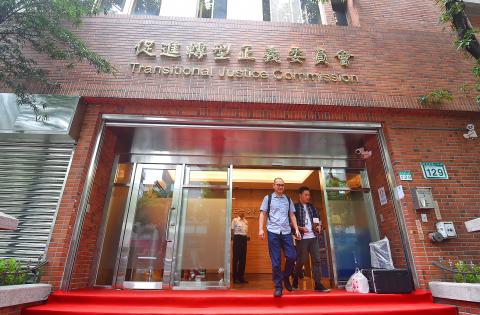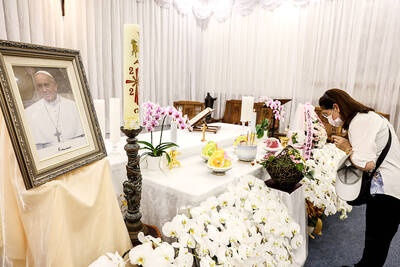The Transitional Justice Commission’s investigative review of victims of political persecution during the White Terror era would include victims of the 228 Incident, and would be a rehabilitative process that could exonerate up to 13,401 people, commission Deputy Chairman Chang Tien-chin (張天欽) said.
The Transitional Justice Act (促進轉型正義條例) mandates the commission to rehabilitate victims of political persecution, authorizing it to open inquiries into treason trials that were conducted during the White Terror era.
The 228 Incident refers to the then-Chinese Nationalist Party (KMT) regime’s violent military crackdown on popular protests and uprisings that began on Feb. 28, 1947. The massacres, which resulted in up to tens of thousands of dead and missing, marked the beginning of the White Terror era, when a state of emergency was declared and the nation was placed under martial law.

Photo: Liao Chen-huei, Taipei Times
The commission has enlisted several institutional partners in its work, including the 228 Memorial Foundation, the National Human Rights Museum and multiple judicial agencies, sources said.
The review process involves the reopening of legal files from the 228 Incident, the White Terror era and subsequent litigations initiated by victims and survivors seeking redress.
After the commission closes an inquiry, it can bring the case to the courts, which could rescind the sedition or espionage conviction of the victim and authorize restitution for any property confiscated in connection with political crimes.
It is expected that the commission would soon move to exonerate a group of victims that includes Chung Yi-jen (鍾逸人), who led anti-KMT guerrilla group Unit 27 during the massacres, the sources said.
Guilty convictions from those trials would all be overturned and the commission is in the process of reviewing the original court verdicts, Chang said.
The commission would publish the results of its inquiries at the appropriate time and request the courts to rescind the convictions in accordance with the law, he said, adding that the commission’s work to restore justice has “progressed very quickly.”
Rehabilitation and restitution of 228 Incident victims proved more complicated than the process for victims of the White Terror era, because an overwhelming majority of the 228 Incident victims were killed without a trial, Chang said.
The commission is working with the 228 Memorial Foundation to organize the documentary evidence for the minority of 228 Incident victims who did receive a trial, Chang said.
The commission plans to exonerate victims in groups so that surviving family members and descendants do not need to wait until the inquiry’s conclusion to receive results, he said.
“Most of those who died in the 228 Incident were shot in the street without a trial being conducted, while others were taken and executed on the authority of some order written on a piece of paper. There were no legal procedures to speak of,” foundation executive director Yang Cheng-long (楊振隆) said.
Deaths during the 228 Incident were therefore distinct from those who were killed later during the Whiter Terror era, whose victims would have gone through show trials, he said.
The foundation has been turning relevant findings over to the commission, with some documents revealing that some Unit 27 members were given trials, he said.
"Those who were tried were the survivors. Those who did not have the benefit of a trial were killed, almost to a man,” Yang said, adding that another 200 survivors were sentenced to the Taiwan Garrison Command’s labor camp.
The foundation is handling a number of cases of political persecution that occurred during the White Terror era, including that of Uyongu’e Yatauyungana (高一生), who was spared by a court despite his role in the Tsou uprising during the 228 Incident, but was later executed for espionage during the White Terror era, he said.
For years, those victims have demanded restitution from the government, he said.
Meanwhile, the commission has completed drafts for the regulations governing the investigation of historical truths involving the authoritarian era, as well as the regulations governing the commission’s investigative procedures.
The two sets of regulations, for which the Executive Yuan has published a preview, will help the commission in accomplishing its mandate to investigate the perpetrators of political persecution during the 228 Incident and the White Terror era.
The regulations governing the investigation of historical truths involving the authoritarian era empower the commission to open inquiries into human rights violations and to establish the degree to which perpetrators were responsible for the political persecution that they carried out on behalf of the state.
As the regulations stipulate, people who were affected by acts of state repression — or academics and researchers — could bring forward issues, events or facts that they believe the commission should consider, Chang said
The commission plans to launch investigations into several high-profile historical events, Chang added.

SECURITY: As China is ‘reshaping’ Hong Kong’s population, Taiwan must raise the eligibility threshold for applications from Hong Kongers, Chiu Chui-cheng said When Hong Kong and Macau citizens apply for residency in Taiwan, it would be under a new category that includes a “national security observation period,” Mainland Affairs Council (MAC) Minister Chiu Chui-cheng (邱垂正) said yesterday. President William Lai (賴清德) on March 13 announced 17 strategies to counter China’s aggression toward Taiwan, including incorporating national security considerations into the review process for residency applications from Hong Kong and Macau citizens. The situation in Hong Kong is constantly changing, Chiu said to media yesterday on the sidelines of the Taipei Technology Run hosted by the Taipei Neihu Technology Park Development Association. With

CARROT AND STICK: While unrelenting in its military threats, China attracted nearly 40,000 Taiwanese to over 400 business events last year Nearly 40,000 Taiwanese last year joined industry events in China, such as conferences and trade fairs, supported by the Chinese government, a study showed yesterday, as Beijing ramps up a charm offensive toward Taipei alongside military pressure. China has long taken a carrot-and-stick approach to Taiwan, threatening it with the prospect of military action while reaching out to those it believes are amenable to Beijing’s point of view. Taiwanese security officials are wary of what they see as Beijing’s influence campaigns to sway public opinion after Taipei and Beijing gradually resumed travel links halted by the COVID-19 pandemic, but the scale of

A US Marine Corps regiment equipped with Naval Strike Missiles (NSM) is set to participate in the upcoming Balikatan 25 exercise in the Luzon Strait, marking the system’s first-ever deployment in the Philippines. US and Philippine officials have separately confirmed that the Navy Marine Expeditionary Ship Interdiction System (NMESIS) — the mobile launch platform for the Naval Strike Missile — would take part in the joint exercise. The missiles are being deployed to “a strategic first island chain chokepoint” in the waters between Taiwan proper and the Philippines, US-based Naval News reported. “The Luzon Strait and Bashi Channel represent a critical access

Pope Francis is be laid to rest on Saturday after lying in state for three days in St Peter’s Basilica, where the faithful are expected to flock to pay their respects to history’s first Latin American pontiff. The cardinals met yesterday in the Vatican’s synod hall to chart the next steps before a conclave begins to choose Francis’ successor, as condolences poured in from around the world. According to current norms, the conclave must begin between May 5 and 10. The cardinals set the funeral for Saturday at 10am in St Peter’s Square, to be celebrated by the dean of the College